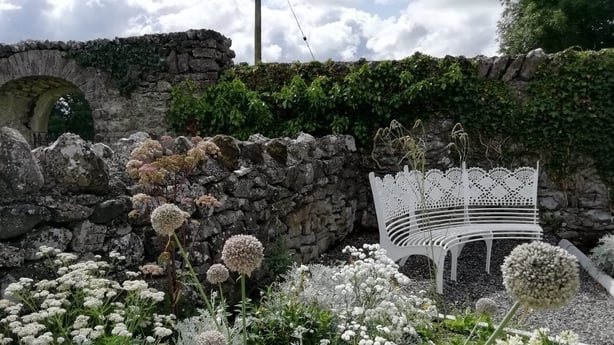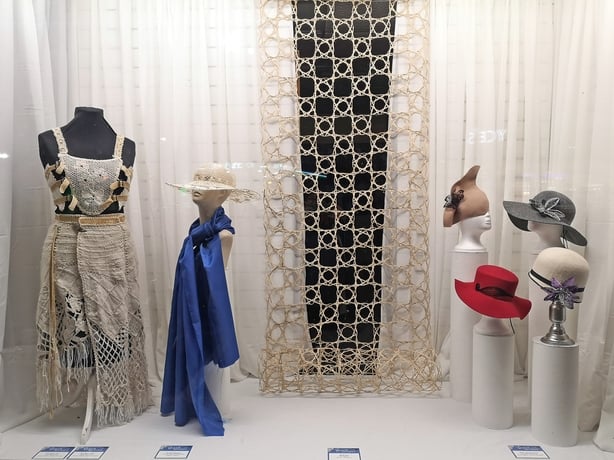Analysis: The Co Galway town was a big player in Irish lacemaking and a new community initiative is reviving that craft for the future
Irish lace was a highly sought after luxury commodity, used to decorate wedding dresses, church vestments and christening gowns. Worn by the wealthiest in Europe, Irish lace was produced by some of the poorest women in Ireland.
Lacemaking was a highly skilled and delicate craft that required little equipment beyond needles or bobbins and fine cotton or linen threads. Because of this, lace making was suitable for remote areas of the country that had little industry and limited employment opportunities.
Lacemaking gave women the opportunity to help support their families from home while still being able to continue looking after their children and attend to domestic duties. In his book on the Limerick lace industry, Amazing Lace (2014), Dr. Matthew Potter describes the years 1820-1914 as the golden years for Irish lace. During this time classic Irish laces such as Carrickmakcross, Kenmare, Limerick and Yougal were developed, with each area having their own unique styles, patterns and techniques.
We need your consent to load this rte-player contentWe use rte-player to manage extra content that can set cookies on your device and collect data about your activity. Please review their details and accept them to load the content.Manage Preferences
From RTÉ Archives, 1983 episode of Hands presented by Maireád Reynolds, Keeper of the Lace Collection at the National Museum of Ireland, on Limerick lace
Headford's bobbin lace
One of the oldest laces in Ireland is a type of bobbin lace from Headford, Co. Galway. The Headford lace industry was established around 1766 by the St George family of Headford Castle. Bobbin lace, or pillow lace, is made by twisting and crossing multiple threads which are attached to weighted bobbins. Traditionally, the bobbins were constructed from bone, ivory or wood. Bobbin lace is made on a hard pillow, either on a table or in the lap.
Norma Owens gives us a detailed description of the history of the craft on the Headford Lace Project website. The earliest contemporary record of lacemaking in Headford was written by Colonel Richard St. George Mansergh St. George and dates to 1790. In An account of Galway, he remarked that "the women of Headford make lace."

The following report, taken from The Illustrated Record & Descriptive Catalogue of the Dublin International Exhibition (1845), paints a picture of life in Headford around this time. "During the autumn of 1845 the writer passed through the little town. It was then like a hive of bees in summer, full of joy and activity, and the hum and noise of industry.
"At some of the cottage doors were groups of neatly-dressed young girls, seated on low stools, their lace pillows on their laps; and while their fingers moved rapidly through the maze of bobbins, their voices filled the air, if not with melody, at least with heart music. Farther on might be seen a couple of elderly women, whose hands had not yet forgotten their cunning, working out intricate, if not very graceful patterns; or perhaps a young mother seated within the doorway, her foot gently moving a cradle, while her fingers plied their busy task."
Lacemaking became a thriving industry in Headford and bobbin lacemaking, coarse linen, and flannel were listed as the town's main industries by 1837. Further accounts show that several hundred people from the area were employed in lacemaking by 1847 and a bobbin making factory was established in Headford in 1885. Census records from 1901 and 1911 show that there were still lacemakers living in Headford and the surrounding areas at the start of the 20th century.

After the First World War, the Irish lace industry collapsed. The intricate and ornate styles of lace were no longer in fashion, and women sought better paid employment in towns and cities. Despite being well known at the time, there are very little references to Headford Lace in historical texts about Irish lacemaking, By the late 20th centuary, the tradition of lacemaking in Headford was almost forgotten.
The Headford Lace revival
The Headford Lace Project was created after a cultural event held in 2016. As part of the event, visual artist Selma Makela designed an art trail of bird-box installations throughout Headford. One of these featured the little-known lacemaking tradition of the town. Since then, Headford Lace Project have run workshops, demonstrations, community collaboration and events, helping to sustain the craft.
We need your consent to load this rte-player contentWe use rte-player to manage extra content that can set cookies on your device and collect data about your activity. Please review their details and accept them to load the content.Manage Preferences
From RTÉ Radio 1, Toss The Bobbin looks at how a Galway community came together around their shared heritage of an unknown lace industry
As well as preserving the tradition of lace making, the Headford Lace Project has reimagined lacemaking through a variety of creative collaborations. An audio trail has been launched around the town telling the story of the lace and a lace garden was created in the town featuring a bench inspired by Headford Lace.
They have also worked on musical collaborations with Drumadore drumming school, Claran Theatre and local songwriters and musicians The Whileaways to create pieces inspired by Headford lace and the lacemakers.
We need your consent to load this Vimeo contentWe use Vimeo to manage extra content that can set cookies on your device and collect data about your activity. Please review their details and accept them to load the content.Manage Preferences
Over the last eight years, the Headford Lace has gone from strength to strength. In 2021, Headford lace was added to the National Inventory for Intangible Cultural Heritage. Both this and the work carried out by the Headford Lace Project will ensure that the craft is safeguarded as part of Ireland's living cultural heritage for generations to come.
Follow RTÉ Brainstorm on WhatsApp and Instagram for more stories and updates
The views expressed here are those of the author and do not represent or reflect the views of RTÉ




